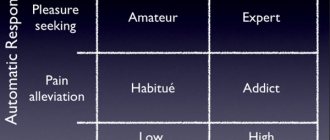The psychology of human behavior and its study is a very complex but interesting process. Why is it pleasant and easy to communicate with one person, while difficult and tense with another? There is a desire to quickly end the conversation and leave, despite the fact that he is a good friend who is always courteous and polite.
We intuitively understand when a person is sincere and when he is disingenuous. That is why we experience conflicting feelings: on the one hand, the person has not done anything wrong, but on the other, there is an inner feeling that tells us that we should stay away from him.
The described situation of interpersonal relationships is explained in psychology.
Definition of the concept
Behavioral psychology is a field of knowledge that explains a person’s nonverbal movements (facial expressions, gestures, intonations) and draws conclusions about how sincere, truthful, confident and open he is.
Very often we make such an assessment unconsciously when we feel uncomfortable when communicating with a familiar person or even avoid him. But in fact, we evaluate his behavioral manifestations, which tell us what he thinks about us, how he treats us, despite the fact that his words may be friendly or neutral.
There are a number of techniques that allow you to determine a person’s true intentions, his emotions, and level of self-esteem. His movements, facial expressions and other features reveal his inner fears, attitudes, complexes, which we catch subconsciously or evaluate consciously if we have certain knowledge and experience.
We perceive the communication process as a general picture; sometimes during a conversation we do not notice what he is wearing, what he is saying, but we pay attention to how he does it, what phrases and words he uses, how he sits and what he holds in his hands. Sometimes some little thing attracts attention and is remembered for a long time: a smell, a speech impediment, an accent, slips of the tongue, incorrect accents, an inappropriate laugh, and so on.
A scientific discipline that helps explain and decipher unconscious nuances in people's behavior that reveal their true intentions is behavioral psychology.
1. What do gestures and facial expressions tell us?
Gestures and facial expressions play a huge role in conversation. But, despite the simplicity of deciphering certain human postures and gestures, they can carry a completely different meaning.
For example, in the psychology of lying there are the main signs of deception: a person does not look into the eyes, touches his mouth, nose, neck. But the interlocutor may touch his nose only because it itches.
Crossed legs or arms - these gestures in the psychology of human behavior are interpreted as distrust, tightness, isolation, but the interlocutor may simply be cold.
Advice on deciphering mannerisms and gestures can often lead to a dead end or put a person in an awkward position. For example, when we see an open posture in our interlocutor, a confident and calm voice, a pleasant, sincere look, we take him for an honest person, but in fact he has fraudulent intentions. Or pick-up artists, how much charm, wit, sincerity, good manners they have - and this is all in order to assert themselves.
2. What does speech and intonation tell us?
Speed of speech, rhythm, volume, intonation greatly influence communication and can tell a lot of additional information about a person, according to behavioral psychology. Science helps to understand the emotional state of a person:
- A calm, reasonable, balanced person speaks rhythmically, slowly, with an average level of volume.
- Impulsiveness of character is revealed by fast and animated speech.
- Those who are insecure or withdrawn speak quietly and uncertainly.
3. Often words are not as important as intonation.
But it should be understood that if a person is in an unfamiliar environment, he may behave differently than in a familiar environment.
Behavioral psychology will allow us to determine the hidden factors that actually influence a person. But in order to see and understand them, you need to be “savvy” with knowledge and attentive to people.
Will
Will is the ability of a person to consciously control his psyche and actions.
Thanks to will, a person is able to consciously control his own behavior and his mental states and processes. With the help of will, a person exerts a conscious influence on the world around him, introducing into it the necessary (in his opinion) changes.
The main sign of will is associated with the fact that, in most cases, it is associated with a person making reasonable decisions, overcoming obstacles and making efforts to realize his plans. A volitional decision is made by an individual in conditions of contrasting, multidirectional needs, drives and motives that have approximately the same driving force, due to which a person always needs to choose one of two/several.
Will always implies self-restraint: acting in one way or another to achieve certain goals and results, realizing certain needs, a person acting according to his own will must always deprive himself of something else, which perhaps seems more attractive and desirable to him. Another sign of the participation of will in human behavior is the presence of a specific plan of action.
An important feature of volitional effort is the absence of emotional satisfaction, but the presence of moral satisfaction that arises as a result of the implementation of the plan (but not in the process of implementation). Very often, volitional efforts are directed not at overcoming circumstances, but at “defeating” oneself, despite one’s natural desires.
Mainly, will is what helps a person overcome life’s difficulties and obstacles along the way; something that helps you achieve new results and develop. As one of the greatest writers of the 20th century, Carlos Castaneda, said: “Will is what makes you win when your mind tells you that you are defeated.” We can say that the stronger a person’s willpower, the stronger the person himself (this means, of course, not physical, but internal strength). The main practice for developing willpower is its training and hardening. You can start developing your willpower with very simple things.
For example, make it a rule to notice those tasks, the postponement of which devastates you, “sucks energy” and the implementation of which, on the contrary, invigorates, energizes and has a positive impact. These are the things that you are too lazy to do. For example, tidying up when you don’t feel like it at all, doing exercises in the morning by getting up half an hour earlier. An inner voice will tell you that this can be postponed or that it is not necessary to do this at all. Don't listen to him. This is the voice of your laziness. Do it as you intended - after that you will notice that you feel more energetic and alert, stronger. Or another example: identify your weaknesses (this could be aimless spending time on the Internet, watching TV, lying on the couch, sweets, etc.). Take the weakest one and give it up for a week, two, a month. Promise yourself that after a designated period you will return to your habit again (if you want, of course). And then - the most important thing: take the symbol of this weakness and keep it with you at all times. But do not give in to the provocations of the “old you” and remember the promise. This is training your willpower. Over time, you will see that you have become stronger and can move on to giving up stronger weaknesses.
But nothing can compare in terms of the power of influence on the human psyche as another property of his personality - emotions.
Deviant behavior and psychology
The phenomenon of such behavior is so complex and widespread that there is a separate science to study it - deviantology, which arose at the intersection of criminology, sociology, psychology and psychiatry.
1. The concept of “deviant” and social behavior in psychology
“Deviation” from Latin means “deviation”. In psychology, behavior that deviates from the norms accepted in society is called deviant or asocial. That is, it is sustainable human behavior that causes real harm to people and society. It is harmful both for others and for the deviant himself.
The psychology of deviant behavior studies such forms of deviation as suicide, crime, prostitution, drug addiction, vagrancy, fanaticism, alcoholism, and vandalism.
Such behavior is associated with malice, violence, aggression, destruction, therefore society has conditionally or legally introduced penalties for violators of social norms, he is isolated, treated, corrected or punished.
2. Personality of the deviant, his psychology, behavioral characteristics
Science does not study how and where a person committed an offense; it is interested in general patterns and personality characteristics.
Causes and sources of antisocial behavior:
- Physiological: genetic predisposition to aggression; diseases of the endocrine system; chromosomal abnormalities.
- Public: imperfect legislation; social inequality; media propaganda of an antisocial lifestyle; hanging “labels”; negative assessments given by relatives.
- Psychological reasons: internal conflicts between conscience and desires; special character; mental disorders; dysfunctional family relationships; too conservative, strict, cruel upbringing in childhood.
The character of deviants often contains such traits as conflict, negativism, dependence, anxiety, aggressiveness, and hostility. They often deceive and do it with pleasure; they like to shift responsibility and blame onto others.
A person’s deviant behavior leads to his social disadaptation, that is, he does not adapt to the conditions of society and, as a result, goes against it.
A child’s behavior cannot be antisocial, since self-control in children under 5 years of age is not yet developed and the process of adaptation to society has just begun.
The most dangerous period in terms of the possibility of developing deviation is between the ages of 12 and 20 years.
3. How to deal with problem behavior?
Most often, people with this behavior end up seeing a psychologist in prisons, in children's colonies, and in addiction treatment centers. Society is engaged in the prevention of deviations in hospitals, schools, dysfunctional families, through the media, but the problem is that there is no individual approach, and a person cannot cope with it on his own. But he may realize the need to change his lifestyle and seek help from specialists.
Psychology of addictive behavior
In psychology, as the science of human behavior, addiction is called attachment to someone or something. It is unacceptable from the point of view of moral or social norms, it threatens health and causes suffering to the person himself.
Addiction harms society and individuals, it limits their development and leads to all sorts of mental illnesses.
More people die from addiction than from crime and war combined. It manifests itself as an escape from problems into an illusory ideal world. Gradually, a person ceases to control his behavior, emotions, thoughts. His entire existence is reduced to an object of dependence, which gradually completely destroys him as a person.
Recently, the spread of drug and alcohol use among young people has become a national disaster. Therefore, the attention of psychologists, psychiatrists, sociologists, narcologists, and lawyers has been drawn to this problem.
Dependent behavior is also called addictive - it is a type of deviant behavior, that is, it is the desire to escape from reality by changing one’s mental consciousness. Behavioral psychology views this as a destructive attitude towards oneself and society.
Addictive behavior is alcoholism, drug addiction, smoking, hypersexuality, gambling, computer addiction, addiction to rich food, shopping.
Dependence has varying degrees of severity: from normal to severe.
Why do some people develop this strong and irresistible attachment, what explains the impulsiveness and insatiability of desire? The answers to these questions are of great importance for society and for each individual.
Psychology of gestures and facial expressions
The psychology of behavior, gestures and facial expressions is the key to a person’s secrets that he wants to hide. As a result of evolution, man has learned to convey thoughts and feelings using words. But along with this skill, he mastered the art of hiding his true plans and intentions, aspirations. You need to be able to “read” your interlocutor by his body movements. Only in this way can you understand what is on his mind and what can be expected from him.
American psychologist Meyerabian Albert believes that when communicating we convey 7% of information verbally, 38% by intonation and tone of voice, and 55% by non-verbal signals.
The main rule of the psychology of gestures and facial expressions says that there is no person in the world who can completely control body movements during a conversation, even if he wants to deliberately mislead the interlocutor.
A person on a subconscious level reacts almost identically to certain situations. Involuntary facial expressions and gestures of a stranger allow you to hear and see what is hidden behind the screen of words.
The most important nonverbal cues:
- Protection. In dangerous or uncomfortable situations, when there is a desire to isolate themselves from their interlocutor, people lean back, cover themselves with a book, folder or other object, cross their legs, cross their arms over their chest, and clench their fists. Their eyes are constantly watching the one from whom they expect a dirty trick. This behavior indicates wariness and tension, as well as a lack of readiness for constructive dialogue.
- Openness. The body is tilted towards the interlocutor, open palms, a benevolent smile - these signals indicate a predisposition to communicate.
- Interest. The absence of gestures, the sparkle in the eyes speak of passion, the person is completely attentive, he is leaning forward and tries not to move so as not to miss a word.
- Boredom. A dull look, rhythmic swinging of a leg, fiddling with something in his hands, drawing, yawning. In sign language in the psychology of communication, this means that the listener has no interest in the topic of the conversation.
- Skepticism. The person agrees with the interlocutor, but makes it clear that he does not trust him with such gestures as rubbing his neck, scratching his ear, cheek, forehead, grinning, resting his chin with his palm.
Psychology of human behavior teaches us to understand the wisdom of non-verbal symbolism and correct mutual understanding of each other.
What can nonverbal speech tell about a person?
Most people underestimate the role of facial expressions and gestures in communication. But it is with the help of non-verbal signals that the first impression of a person is created. And it will be remembered for a long time. Gestures help or distract listeners from the conversation; even their absence carries information about the person speaking.
So, what do these or other gestures mean:
- a limp handshake speaks of a person’s shyness and uncertainty, and vice versa, a strong one speaks of a desire to impose one’s opinion;
- if a woman straightens her hair, it means she is preening;
- if a person gestures with only one hand, this indicates his unnaturalness;
- touching the forehead, mouth, nose is regarded as deception;
- crossing your arms indicates the interlocutor’s skepticism and distrust of the person speaking;
- Slouching and hunching indicate a person’s low self-esteem and uncertainty.
It is necessary to develop observation skills; it helps to collect additional information about the people with whom you have to communicate.
The main thing in psychology regarding human behavior is the ability to listen and see. After all, the sound of the voice and its intonation, gestures and facial expressions of the interlocutor are of great importance.
Basic character traits
Personality orientation - what is it in psychology, its types
Character makes a person unique, helps to stand out from the crowd. Any individual is characterized by the desire to be accepted by society, to become part of a team, family or social group.
Additional Information. Nobody wants to be an outcast. Therefore, the need to be around other people is a natural human need.
To become a part of any society, an individual must not only perform useful functions, but also have a certain character. Knowing which hypothetical traits are welcomed in a group and which are rejected, it will be much easier to build communication with people.
Negative traits
Negative personality traits do not lead an individual to positive results. Negative manifestations of character are condemned in society. Among the main negative character traits, the following options can be distinguished:
What does a man's behavior tell us?
The psychology of the strong half of humanity is always associated with the performance of certain actions: to conquer, to obtain, to win. Therefore, in their games from childhood there is always a spirit of competition in endurance, strength of character, and strength.
All their actions are aimed at the final result. From childhood, their self-esteem is based on abilities and achievements.
The words and actions of men and women are different. Therefore, when talking with them, you need to pay attention to their general demeanor. If during a conversation he crosses his legs or arms, sits half-turned, it means he is not listening, he seems to be shutting himself off from the information. If he looks into your eyes and periodically glances at your lips, it means he is interested in the conversation.
If a man adjusts his tie, frequently changes his position, has high eyebrows and wide eyes, he is interested in the woman he is talking to.
If he avoids looking, fiddles with buttons or other small parts of clothing, covers his mouth with his hand, straightens the collar of his shirt, this means the interlocutor is trying to hide something.
It should be remembered that all these non-verbal signals are statistical averages. The psychology of the stronger sex is much more complex and depends on the person and his emotional fullness.
Emotions
Emotions are a mental reaction to any events. An emotional reaction is always subjective and has nothing to do with objective facts. Emotions are associated with the individual needs of the individual, as well as beliefs and experiences.
By type, emotions can be positive or negative. The first includes joy, passion, enthusiasm, faith, optimism, hope, satisfaction. The second - boredom, irritation, disappointment, anxiety, despondency, fear, sadness, excitement.
Read also: How to grow a mushroom biome terraria
Psychologist B.I. Dodonov proposed the following classification of emotions according to the specifics of the situations in which they arise:
- communicative;
- altruistic;
- practical (occurs after the successful implementation of the plan);
- gloric (associated with the need for self-affirmation);
- fearful (occurs in situations of risk, danger);
- romantic;
- aesthetic;
- Gnostic (associated with the desire for knowledge);
- active (associated with accumulation, gathering);
- hedonistic (associated with any pleasures).
Emotions are situational experiences. They are short-lived. If you continue to experience the same thing after the situation ends, then this is the feeling. However, in practice, the first and second are often identified.
What do children tell us with their antics?
The psychology of child behavior is based on three basic principles:
- a sense of belonging to the family system;
- emotional connection with parents;
- own importance.
When the child's basic needs are satisfied (sleep, food, water), he has a desire to satisfy emotional ones. He needs to have some responsibilities assigned only to him. That is, something that depends only on him. This increases his self-esteem. He must feel that he is making a contribution to the life of the family, know that his opinion is taken into account, that he also controls events.
How to help a child and satisfy his need for significance and involvement?
First of all, it is necessary to form a close emotional connection with mom, dad and other relatives. And involve the child in discussing family problems and making decisions.
If a conflict arises with a child, talk to him; perhaps he lacks parental attention. It is necessary to let him know that he is very important and needed.
Spend time with your child at least 20 minutes a day, but it should be devoted only to him. Children love to fool around and play with their parents, this is how the strongest emotional connection is established. Do not teach him how to play with certain toys, it is better to remain non-judgmental. He must have an area of life in which he alone must make decisions. Try to become a friend, not a teacher.
Psychological properties of the crowd
In this case, a crowd means not just a gathering of a large number of people, but people united by a common center of attention, interests and emotional state. This could be a crowd of football fans, participants in rallies and demonstrations, fans and concertgoers of their favorite performers, etc. Depending on the type of crowd, different types of emotions may be inherent: aggression, fanaticism, heroism, selflessness.
Initially, a crowd is not characterized by the presence of common goals; it is mostly a spontaneous formation, guided by instincts and a leader.
The psychological characteristics of the behavior of any person in a crowd are somewhat similar to behavior in a dangerous situation. It is controlled primarily by instincts, not by consciousness. Only the reasons are different. In a dangerous situation, instinct is individual and rather determined by the needs of a particular person. Being in a crowd, an individual becomes, as it were, part of one huge biological organism - the “crowd”.
According to studies of this phenomenon in different countries, anyone is susceptible to the influence of the crowd as soon as they become part of it. And this does not depend on the initial cultural or educational level of the participant, his type of character or country of residence. All such crowds of people have common features.
The main features of the behavior of the “man of the crowd” are:
- increased impulsiveness of actions;
- decreased verbal interpersonal communication;
- the tendency to unconsciously imitate the behavior of leaders and quickly respond to their commands and calls;
- extreme categorical judgments and opinions;
- emotional instability, dependence of mood on others: rapid emergence of emotions and transition between their extreme manifestations (from anger to delight on command);
- high emotional arousal, which can be recognized by nervous movements, distracted gaze, frequent shouting of some cries or mottos;
- lack of ability to create: the crowd tends mainly to destroy;
- auditory or visual hallucinations may occur;
- tendency to cluster in denser groups;
- increased emotional and mental stress provokes seizures, convulsions or epilepsy in nervously ill members of the crowd;
- chaotic physical activity, psychomotor agitation, poor control of motor coordination, tendency to perform the same type of movements, increased aggressiveness;
- a tendency to understand and make extremely simple and primitive decisions: the “man of the crowd” is simply not capable of complex mental work and rational conclusions.
With all this, when a person is in a crowd, his individual character traits are erased, he actually merges with the crowd. The process is led by the crowd, and its element only unconsciously submits; it is temporarily deprived of its own views and values. He easily and without making a conscious decision crosses the line of his own moral values.
The intellectual abilities of each individual person in a crowd are obviously lower than such a person in ordinary life.
Psychology of women
The psychology of the fair half of humanity is based on several circumstances:
- Character type. Most women are sanguine. They are active, they are characterized by mood swings, they know how to manage feelings, and subordinate circumstances to their desires.
- Upbringing is what parents instilled in a little girl that determines her actions and behavior.
- Experience - if she has faced negativity all her life, she stops trusting people and becomes lonely. Her behavior is different from the standard.
The psychology of a woman’s behavior is determined by her attitude towards a man. Psychologists believe that women have a natural ingenuity that helps them in life. But they primarily direct their ingenuity to relationships with men. For example, they try to appear strong and independent, they always have some hobbies and hobbies, often planned personal time, and so on.
Raising the younger generation
One of the most important moments in raising the younger generation is conversations about behavior at school. The purpose of such conversations should be to expand the knowledge of schoolchildren about the culture of behavior, to explain to them the moral meaning of this concept, as well as to develop in them the skills of correct behavior in society. First of all, the teacher must explain to students what behavior is, that it is inextricably linked with the people around them, that how the teenager behaves determines how easy and pleasant it will be for these people to live next to him. Teachers should also cultivate positive character traits in children using the examples of books by various writers and poets. The following rules also need to be explained to students:
- how to behave at school;
- how to behave on the street;
- how to behave in a company;
- how to behave in city transport;
- how to behave when visiting.
It is important to pay special attention, especially in high school, to such an issue as a girl’s behavior in the company of classmates, as well as in the company of boys outside of school.
Forms of human behavior
Based on socionics and Dellinger’s theory of psychoforms, forms of human behavior were identified:
- Dominant is the behavior of leaders, realists, and practitioners.
- Creative - characteristic of people with abstract-imaginative thinking. They rely more on intuition, have ingenuity, premonition, imagination, and are completely divorced from reality.
- A harmonizing form of behavior is characteristic of people who are endowed with empathy, ethics, and subtle diplomacy.
- Normalizing is the behavior of logical people capable of analyzing facts.
Usually people have a combination of two types of behavior, one of which is more pronounced.










